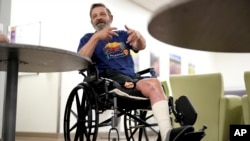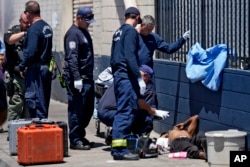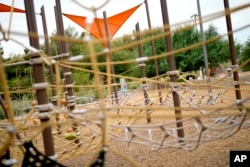Ron Falk lost his right leg, had extensive skin grafting on the left one and is still recovering a year after collapsing on the searing asphalt outside a Phoenix convenience store where he stopped for a cold soda during a heat wave.
Now using a wheelchair, the 62-year-old lost his job and his home. He’s recovering at a medical respite center for patients with no other place to go; there he gets physical therapy and treatment for a bacterial infection in what remains of his right leg, which is too swollen to use the prosthesis he’d hoped would help him walk again.
“If you don’t get somewhere to cool down, the heat will affect you,” said Falk, who lost consciousness due to heat stroke. “Then you won’t know what’s happening, like in my case.”
Sizzling sidewalks and unshaded playgrounds pose risks for surface burns as air temperatures reach new summertime highs in Southwest U.S. cities such as Phoenix, which just recorded its hottest June on record. The average daytime high was 43 degrees Celsius (109.5 degrees Fahrenheit), without a single 24-hour high below 37.7 Celsius (100 Fahrenheit).
Young children, older adults and homeless people are especially at risk for contact burns, which can occur in seconds when skin touches a surface of 82 C (180 F).
Since the beginning of June, 50 people have been hospitalized with such burns, and four have died at Valleywise Health Medical Center in Phoenix, which operates the Southwest’s largest burn center, serving patients from six states, according to its director, Dr. Kevin Foster. About 80% were injured in metro Phoenix.
Last year, the center admitted 136 patients for surface burns from June through August, up from 85 during the same period in 2022, Foster said. Fourteen died. One out of five were homeless.
“Last year’s record heat wave brought an alarming number of patients with life-threatening burns,” Foster said of a 31-day period with temperatures at or above 43 C (110 F) during Phoenix’s hottest summer.
In Las Vegas, which regularly sees summertime highs in the triple digits, 22 people were hospitalized in June alone at the University Medical Center’s Lions Burn Care Center, said spokesperson Scott Kerbs. That's nearly half as many as the 46 hospitalized during all three summer months last year.
As in Phoenix, the desert sun punishes Las Vegas for hours every day, frying outdoor surfaces such as asphalt, concrete and metal doors on cars and playground equipment such as swings and monkey bars.
Contact with pavement
Surface burn victims often include children injured walking barefoot on concrete or touching hot surfaces, adults who collapsed on a sidewalk while intoxicated, and older people who fell on the pavement due to heat stroke or another medical emergency.
Some don’t survive.
Thermal injuries were among the main or contributing causes of last year’s 645 heat-related deaths in Maricopa County, which encompasses Phoenix.
One victim was an 82-year-old woman with dementia and heart disease admitted to a suburban Phoenix hospital after being found on the scorching pavement on an August day that hit 41.1 C (106 F).
With a body temperature of 40.5 C (105 F), the woman was rushed to the hospital with second-degree burns on her back and right side, covering 8% of her body. She died three days later.
Many surface burn patients also suffered potentially fatal heat stroke.
Valleywise hospital’s emergency department recently adopted a new protocol for all heat stroke victims: submerging patients in a bag of slushy ice to quickly bring down body temperature.
Recovery for those with skin burns was often lengthy, with patients undergoing multiple skin grafts and other surgeries, followed by months of recovery in skilled nursing or rehabilitation facilities.
Bob Woolley, 71, suffered second- and third-degree burns to his hands, arms, leg and torso after he stumbled onto the broiling backyard rock garden at his Phoenix home while wearing only swim trunks and a tank top.
“The ordeal was extremely painful; it was almost unbearable,” said Woolley, who was hospitalized at the Valleywise burn center for several months. He said he considers himself “95% recovered” after extensive skin grafts and physical therapy and has resumed some former activities such as swimming and motorcycle riding.
Children among the burned
Some burn victims in Phoenix and Las Vegas were children.
“In many cases, this involves toddlers walking or crawling onto hot surfaces,” Kerbs said of those hospitalized at the Las Vegas center.
Foster said about 20% of the hospitalized and outpatient skin-burn victims seen at the Phoenix center are children.
Small children aren’t fully aware of the harm a sizzling metal door handle or a scorching sidewalk can cause.
“Because they’re playing, they don’t pay attention,” said urban climatologist Ariane Middel, an assistant professor at Arizona State University who directs the SHaDE Lab, a research team that studies the effects of urban heat.
“They may not even notice that it’s hot.”
In measuring surface temperatures of playground equipment, the team found that in 37.7-degree C (100 F) weather without shade, a slide can heat up to 71.1 C (160 F), but a covering can bring that down to 43.8 C (111 F). A rubber ground cover can hit as high as 86.6 C (188 F), a handrail can heat up to 48.8 C (120 F) and concrete can reach 55.5 C (132 F).
Many metro Phoenix parks have covered picnic tables and plastic fabric stretched over play equipment, keeping metal or plastic surfaces up to 30 degrees Fahrenheit cooler. But plenty do not, Middel said.
She said cooler wood chips are better underfoot than rubber mats, which were designed to protect kids from head injuries but soak up heat in the broiling sun. Like rubber, artificial turf gets hotter than asphalt.
“We need to think about alternative surface types, because most surfaces we use for our infrastructure are heat sponges," Middel said.
Pets in danger, too
Hot concrete and asphalt also pose burn risks for pets.
Veterinarians recommend dogs wear booties to protect their paws during outdoor walks in summer or keeping them on cooler grassy areas. Owners are also advised to make sure their pets drink plenty of water and don’t get overheated. Phoenix bans dogs from the city’s popular hiking trails on days the National Weather Service issues an excessive heat warning.
Recovering at Phoenix's Circle the City, a respite care facility he was sent to after being released from Valleywise's burn unit, Falk said he never imagined the Phoenix heat could cause him to collapse on the broiling asphalt in his shorts and T-shirt.
Because he wasn't carrying identification or a phone, no one knew where he was for months. He has a long road ahead but still hopes to regain part of his old life, working for a concessionaire for entertainment events.
“I kind of went into a downward spiral,” Falk said. “I finally woke up and said, ’Hey, wait, I lost a leg.' But that doesn’t mean you’re useless.”









